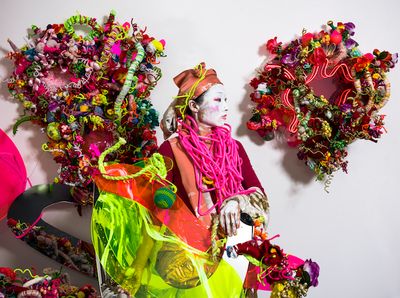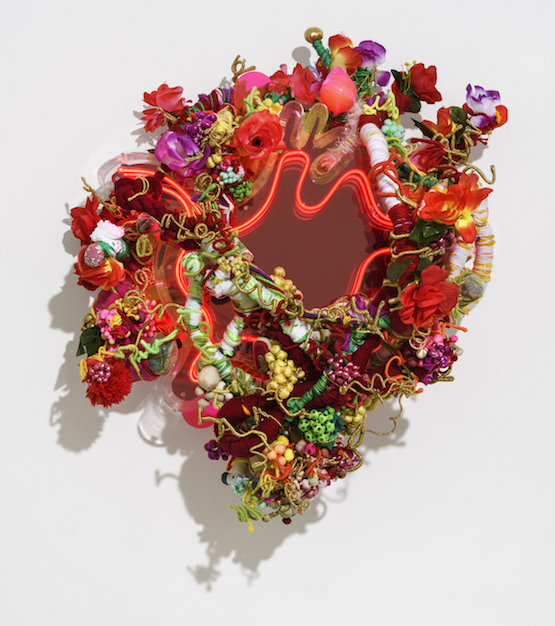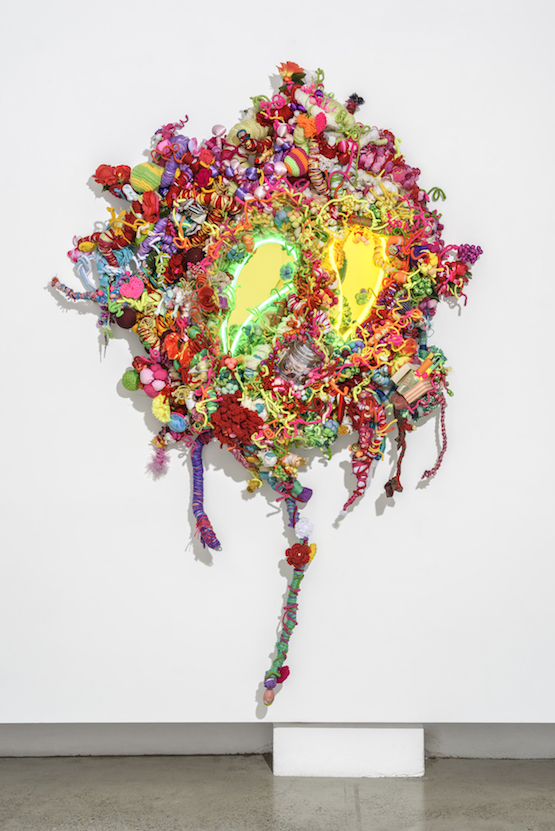Hiromi Tango at Sullivan + Strumpf, Sydney
Hiromi Tango (b. 1976) lives and works in northern New South Wales. She moved from Japan to Australia in 1998, after graduating with a Bachelor of Arts from Japan Women’s University, Tokyo.
Reflecting Tango’s own personal journey with emotional trauma, mental health research is the genesis for many of her works. She has a longstanding interest in the potential for visual and performance arts to contribute to social, emotional and neurological development and recovery processes.
Tango has undertaken several major community engagement works including Pistil, a sculptural site-specific installation that was created for Contemporary Australia: Women
, Queensland Art Gallery / Gallery Of Modern Art (2012), and Dance (2013), an immersive environment created through soft sculptural forms and incorporating interactive elements of light, sound and movement at the Museum of Contemporary Art in Sydney.

Other recent projects and exhibitions include Monster Hotel, (Out of the Box Festival, QPAC, Brisbane 2014), Hiromi Hotel: Moon Jellies, (Hazelhurst Regional Gallery and Arts Centre, Sydney 2013); Traces—Blue (with Craig Walsh at Art Setouchi , Japan, 2013) and Home—Gwangju (with Craig Walsh, Gwangju Biennale, Korea, 2012).
We caught up with Hiromi Tango on the occasion of her forthcoming exhibition Fluorescence at Sullivan+Strumpf in Sydney.
Your work is very complex– at once chaotic yet also playful and magical. The vibrant color palette, textural complexity and intricate detail is mesmerising and at the same time almost kitsch. How would you define yourself as an artist?
My nickname is Chameleon, and it may well describe my belief. I am mindful of the qualities that an artwork may embody: dynamic, flexible, fluid, emotional, empathetic and informative. New scientific research may discover something completely new to us, but a yes today can just as easily become a no tomorrow. I want to engage with what’s current, and make a prompt change. In terms of the kitsch aspect, ‘one—off ‘, unique qualities in art are important for me, so I don't think it is kitsch. However, I ask people to donate everyday material with their deep memories attached, and this contributes to the general common feel. In this aspect, my work may be regarded as kitsch. It sounds contradictory, but I am interested in both the unique and the universal qualities art can convey. But for me, it is more important to be current, to experiment, and to challenge. I want us to keep questioning.Hiromi Tango, Tango Heart, 2015. Neon and mixed media, 90 x 90 x 20 cm. Image courtesy the artist and Sullivan+Strumpf, Sydney
And is there an underlying message you are trying to convey in your work?
Through this work, I want to remind myself to prioritise spending time with people and things that are important for me, beyond what is required to be done immediately or what is expected from others. I want to remind myself to be alert with my bodily responses beyond mere cognition. The messages are intended more towards me than for others.You are a proponent for the healing power of art and have been involved with a number of projects related to mental health issues. Using an example such as Dance (2013) at the Museum of Contemporary art in Sydney, please share some of your experiences and thoughts about the potential for arts engagement to assist with mental health development.
It is such a delicate topic to discuss, and I am not sure if I could express in short, but I will try. I am passionate about mental health as this is something I personally struggle with. It is important for me to remain an artist, and share a little bit of who I am and enjoy the engagement. I found it interesting to work within the field of mental health development as an artist, and I keep reminding myself that it is subjective, and that theory and practice are different. Arts engagement can enrich emotions and create a beautiful experience, but to suggest it might be a “cure “ would be missing the point about the value that the arts can bring to our lives.
Hiromi Tango, Boundaries (Green), 2015. Neon and mixed media. 80 x 160 x 20 cm. Image courtesy the artist and Sullivan+Strumpf, Sydney
The title of your forthcoming show at Sullivan and Strumpf, Fluorescence, suggests a continuing exploration of the importance of memory and trauma in shaping individuals psychological development. Can you tell us about the new works? What will you be showing?
Yes. In Fluorescence, I am exploring my own complex raw emotions and bodily responses about the death of my father. It is a very personal piece, and maybe dangerous for me, as I am engaging with emotions that I haven’t even been able to articulate yet. But I am finding the process quite cathartic.My father’s brain and bodily function have deteriorated dramatically over the last 12 months, especially his hearing, eyesight, and memory. I made series of artworks based on the memory of my father and my evolving relationship with him. It is the process of connecting our similarities, a remembrance between us. I realised that my time with him is limited, and I need to make artwork about him, and about us.
For me, the works are a way of connecting the segment of memory about my father that at one time I deliberately lost. Now I am re-gathering the essence of him, of what I remember of him, and trying to understand something very important—although I don’t yet know what it is. When I learned that once the retinal function deteriorates as you get older, you don't see fluorescent colours as vividly, it made me think about how my father is engaging with his everyday life with limited colour, light, sound, and physical movement. This compelled me to make artworks around the theme of fluorescence and light, which led me to create the heart series about my search for my lost memory about my father.
Hiromi Tango, Lost Memory (Tears), 2015. Neon and mixed media. 130 x 130 x 35 cm. Image courtesy the artist and Sullivan+Strumpf, Sydney
And the exhibition coincides with a performance too? Please you tell us about this?
Yes. Fluorescence is me, who is dancing with my father of now and of old and it is connecting the lost memory and essence of my father particularly when he was younger and energetic. I do not want to forget who he was. The works are performative sculptures—a work that continues to evolve and develop over time, almost as a living organism. With each new iteration, I am able to weave in my emotions and issues that I am challenged by at the time, experimenting with materials and ideas in different ways as I create the sculpture. Each performance is unique, responding in context to the sculpture in its current iteration.Looking at your work, I am curious about your process. Woven and wrapped by hand, with extremely intricate detail, they suggest a very intense almost meditative process. How important is the process to you—is it in some way cathartic, part of your own journey of healing?
It is important for me to be physical in the creation of work, including painful processes; it must be my way of adding texture and materiality to the emotions that we cannot physically touch unless we use artworks. The emotional journey for me is the physical experience. The more intricate the detail, the more painful the physical process. My fingers and wrists are sore. My hands have so many cuts from working with wire, and it relates to a painful process rather than a meditative one. However, as long as you don't overdo it like me, several studies have been published about how repetitious movement can have a meditative and healing effect for cognitive function.
Hiromi Tango, New Memory (Dandelion), 2015. Neon and mixed media. 90 x 90 x 40 cm. Image courtesy the artist and Sullivan+Strumpf, Sydney
Your first commercial exhibition was at Sullivan+Strumpf just over a year ago. How have you found the experience of making work for a commercial show?
I don't really differentiate whether it is a commercial show or community engagement project. They are delicately interwoven. The role of a commercial show in general may associate an objective of sales, but my experience working with Sullivan+Strumpf is more akin to them being part of my creative team. I am constantly encouraged not to be scared to be an artist and create the work I want. The Sullivan+Strumpf team gives me full freedom and trust in my creative process, and this allows me to dedicate my full self to create artworks. They take great care of me, so I can concentrate on making art.What would you say is the greatest challenge you face as an artist?
To remain authentic, and keep pushing ideas, while remaining focused and not to be distracted by viewer feedback. I need to create artwork that is authentic to me.
What else are you currently working on?
In terms of community engagement work I have two exciting projects happening currently. One is a new site specific artwork called Art Magic Remnant for Lismore Regional Gallery, opening September 12th. The other one is the Art Magic Climbing Plant for Cairns Regional Gallery, opening in November. I am also working on a project for the Adelaide Biennale 2016. Apart from that, I am continuing to do brain research and exploring working with diverse materials including feelings, raw emotions and bodily responses.—[O]












































































































































































